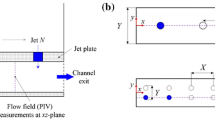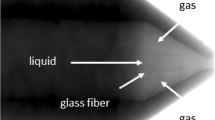Abstract
High-speed liquid jets have been applied to many fields of engineering, science and medicine. It is therefore of benefit to all these areas to investigate their characteristics by modern and inexpensive methods using a computational fluid dynamics (CFD) technique. Previously, high-speed liquid jets have been studied experimentally using a momentum exchange method, called the “impact driven method (IDM)”, by which the impact of a high-velocity projectile on the liquid package contained in the nozzle cavity produced the jet. The shock pulse reflections in the cavity caused by the impact then drove a multiple pulsed jet from the nozzle exit. In this study, a two-fluid simulation consisting of liquid and air can be successfully calculated by using a two-phase flow mixture model and a moving mesh for the projectile motion. The CFD results show good agreement to the results of previous experimental studies, both quantitatively and qualitatively. For the first time, the wave propagation within the liquid in the nozzle has been captured and analyzed, thereby demonstrating the dynamic characteristics of multiple pulsed high-speed liquid jets initiated by the IDM. This provides a breakthrough in the simulation of the supersonic injection of a liquid into air by using a well-known and user-friendly CFD software. It is useful fundamental knowledge for future studies of high-speed injection with applications in all its related fields.
Similar content being viewed by others
References
Giudice E.L., Campbell J.D.: Needle-free vaccine delivery. Adv. Drug Deliv. Rev. 58, 68–89 (2005)
Baxter J.S., Mitragotri S.: Needle-free jet injections: dependence of jet penetration and dispersion in the skin on jet power. J. Control Release 97, 527–535 (2009)
Bowden F.P., Brunton J.H.: Damage to solids by liquid impact at supersonic speed. Nature 181, 873–875 (1958)
Keefe J.D.O., Wrinkle W.W., Scully C.N.: Supersonic liquid jet. Nature 213, 23–25 (1967)
Ryhm L.R.: Analysis of unsteady incompressible jet nozzle flow. Z. Angew. Math. Phys. 24, 149–164 (1973)
Lesser M.: Thirty years of liquid impact research: a tutorial review. Wear 186–187, 28–34 (1995)
Shi, H.H.: Study of hypersonic liquid jets. Ph.D. Thesis, Tohoku University, Japan (1994)
Pianthong K., Milton B.E., Behnia M.: Generation and shock characteristics of unsteady pulsed supersonic liquid jets. At. Sprays 13, 425–620 (2003)
Matthujak A., Hossein S.H.R., Takayama K., Sun M., Voinovich P.: High speed jet formation by impact acceleration method. Shock Waves 16, 405–419 (2007)
Mahmoud H., Kriaa W., Mhiri H., Palec G.L., Bournot P.: Numerical analysis of recirculation bubble sizes of turbulent co-flowing Jet. Eng. Appl. Comp. Fluid. 6, 58–73 (2012)
Pianthong K., Zakrzewski S., Behnia M., Milton B.E.: Characteristics of impact driven supersonic liquid jets. Exp. Therm. Fluid. Sci. 27, 589–598 (2003)
Zakrzewski S., Milton B.E., Pianthong K., Behnia M.: Supersonic liquid fuel jets injected into quiescent air. Int. J. Heat Fluid Flow 25, 833–840 (2004)
Margot X., Hoyas S., Gil A., Patouna S.: Numerical modelling of cavitation: validation and parametric studies. Eng. Appl. Comp. Fluid 6, 15–24 (2012)
Singhal A.K., Athavale M.M., Li H., Jaing Y.: Mathematical basic and validation of the full cavitation model. J. Fluids Eng. 124, 617–624 (2002)
Pianthong K., Matthujak A., Takayama K., Saito T., Milton B.: Visualization of supersonic liquid fuel jets. J. Flow Vis. Image Process 13, 217–242 (2006)
Pianthong K., Takayama K., Milton B., Behnia M.: Multiple pulsed hypersonic liquid diesel fuel jets driven by projectile impact. Shock Waves 14, 73–82 (2005)
Pianthong K., Matthujak A., Takayama K., Miton B.E., Behnia M.: Dynamic characteristics of pulsed supersonic fuel sprays. Shock Waves 18, 1–9 (2008)
Fluent Inc.: Fluent 6.3 User Guides. New Hampshire (2005)
Author information
Authors and Affiliations
Corresponding author
Additional information
Communicated by E. Timofeev.
Rights and permissions
About this article
Cite this article
Seehanam, W., Pianthong, K., Sittiwong, W. et al. Investigation on the generation process of impact-driven high-speed liquid jets using a CFD technique. Shock Waves 22, 465–475 (2012). https://doi.org/10.1007/s00193-012-0379-6
Received:
Revised:
Accepted:
Published:
Issue Date:
DOI: https://doi.org/10.1007/s00193-012-0379-6




